It’s a Cascade of 14nm CPUs: AnandTech’s Intel Core i9-10980XE Review
by Dr. Ian Cutress on November 25, 2019 9:00 AM ESTCPU Performance: System Tests
Our System Test section focuses significantly on real-world testing, user experience, with a slight nod to throughput. In this section we cover application loading time, image processing, simple scientific physics, emulation, neural simulation, optimized compute, and 3D model development, with a combination of readily available and custom software. For some of these tests, the bigger suites such as PCMark do cover them (we publish those values in our office section), although multiple perspectives is always beneficial. In all our tests we will explain in-depth what is being tested, and how we are testing.
All of our benchmark results can also be found in our benchmark engine, Bench.
Application Load: GIMP 2.10.4
One of the most important aspects about user experience and workflow is how fast does a system respond. A good test of this is to see how long it takes for an application to load. Most applications these days, when on an SSD, load fairly instantly, however some office tools require asset pre-loading before being available. Most operating systems employ caching as well, so when certain software is loaded repeatedly (web browser, office tools), then can be initialized much quicker.
In our last suite, we tested how long it took to load a large PDF in Adobe Acrobat. Unfortunately this test was a nightmare to program for, and didn’t transfer over to Win10 RS3 easily. In the meantime we discovered an application that can automate this test, and we put it up against GIMP, a popular free open-source online photo editing tool, and the major alternative to Adobe Photoshop. We set it to load a large 50MB design template, and perform the load 10 times with 10 seconds in-between each. Due to caching, the first 3-5 results are often slower than the rest, and time to cache can be inconsistent, we take the average of the last five results to show CPU processing on cached loading.
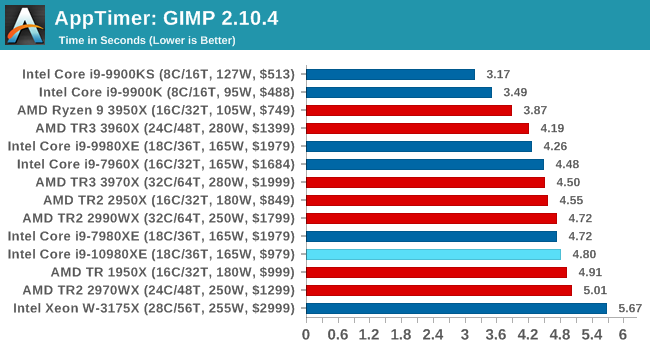
We saw a slight regression here with the 10980XE, which may be down to some of the security updates given that this benchmark tests loading a program which can involve user mode changes.
3D Particle Movement v2.1: Brownian Motion
Our 3DPM test is a custom built benchmark designed to simulate six different particle movement algorithms of points in a 3D space. The algorithms were developed as part of my PhD., and while ultimately perform best on a GPU, provide a good idea on how instruction streams are interpreted by different microarchitectures.
A key part of the algorithms is the random number generation – we use relatively fast generation which ends up implementing dependency chains in the code. The upgrade over the naïve first version of this code solved for false sharing in the caches, a major bottleneck. We are also looking at AVX2 and AVX512 versions of this benchmark for future reviews.
For this test, we run a stock particle set over the six algorithms for 20 seconds apiece, with 10 second pauses, and report the total rate of particle movement, in millions of operations (movements) per second. We have a non-AVX version and an AVX version, with the latter implementing AVX512 and AVX2 where possible.
3DPM v2.1 can be downloaded from our server: 3DPMv2.1.rar (13.0 MB)

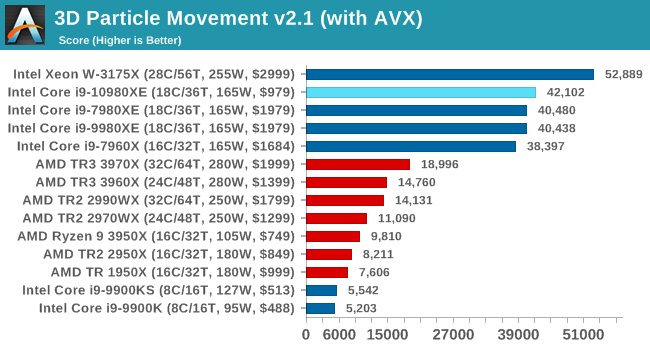
The extra frequency shows a bit here in MT mode, but otherwise equal performance to the 9980XE.
Dolphin 5.0: Console Emulation
One of the popular requested tests in our suite is to do with console emulation. Being able to pick up a game from an older system and run it as expected depends on the overhead of the emulator: it takes a significantly more powerful x86 system to be able to accurately emulate an older non-x86 console, especially if code for that console was made to abuse certain physical bugs in the hardware.
For our test, we use the popular Dolphin emulation software, and run a compute project through it to determine how close to a standard console system our processors can emulate. In this test, a Nintendo Wii would take around 1050 seconds.
The latest version of Dolphin can be downloaded from https://dolphin-emu.org/
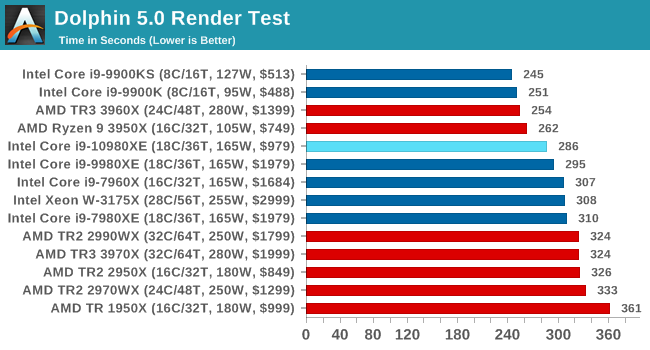
DigiCortex 1.20: Sea Slug Brain Simulation
This benchmark was originally designed for simulation and visualization of neuron and synapse activity, as is commonly found in the brain. The software comes with a variety of benchmark modes, and we take the small benchmark which runs a 32k neuron / 1.8B synapse simulation, equivalent to a Sea Slug.
Example of a 2.1B neuron simulation
We report the results as the ability to simulate the data as a fraction of real-time, so anything above a ‘one’ is suitable for real-time work. Out of the two modes, a ‘non-firing’ mode which is DRAM heavy and a ‘firing’ mode which has CPU work, we choose the latter. Despite this, the benchmark is still affected by DRAM speed a fair amount.
DigiCortex can be downloaded from http://www.digicortex.net/
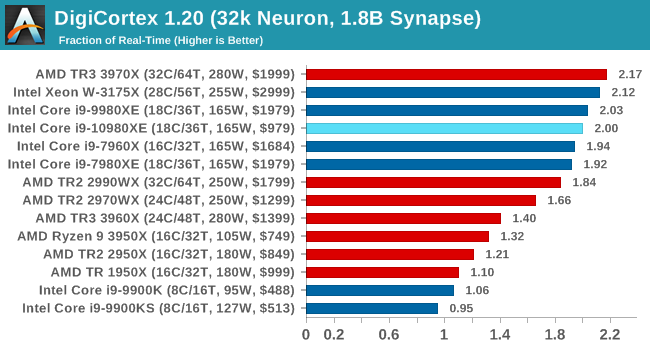
y-Cruncher v0.7.6: Microarchitecture Optimized Compute
I’ve known about y-Cruncher for a while, as a tool to help compute various mathematical constants, but it wasn’t until I began talking with its developer, Alex Yee, a researcher from NWU and now software optimization developer, that I realized that he has optimized the software like crazy to get the best performance. Naturally, any simulation that can take 20+ days can benefit from a 1% performance increase! Alex started y-cruncher as a high-school project, but it is now at a state where Alex is keeping it up to date to take advantage of the latest instruction sets before they are even made available in hardware.
For our test we run y-cruncher v0.7.6 through all the different optimized variants of the binary, single threaded and multi-threaded, including the AVX-512 optimized binaries. The test is to calculate 250m digits of Pi, and we use the single threaded and multi-threaded versions of this test.
Users can download y-cruncher from Alex’s website: http://www.numberworld.org/y-cruncher/

Agisoft Photoscan 1.3.3: 2D Image to 3D Model Conversion
One of the ISVs that we have worked with for a number of years is Agisoft, who develop software called PhotoScan that transforms a number of 2D images into a 3D model. This is an important tool in model development and archiving, and relies on a number of single threaded and multi-threaded algorithms to go from one side of the computation to the other.
In our test, we take v1.3.3 of the software with a good sized data set of 84 x 18 megapixel photos and push it through a reasonably fast variant of the algorithms, but is still more stringent than our 2017 test. We report the total time to complete the process.
Agisoft’s Photoscan website can be found here: http://www.agisoft.com/
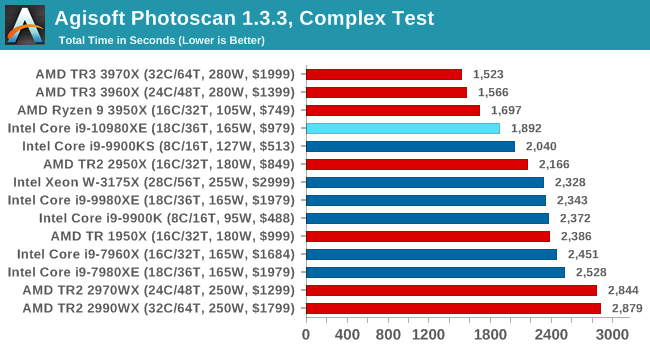
The 10980XE here becomes the fastest Intel CPU we've tested on Photoscal, with a sizeable uplift over the 9980XE. This is likely due to the faster memory.












79 Comments
View All Comments
Korguz - Thursday, November 28, 2019 - link
yep.. i knew gondalf wouldnt answer my question...0ldman79 - Thursday, December 5, 2019 - link
That is ignorant.Adding L3 cannot increase processing. The L3 can only improve feeding of data, further the L3 is a victim cache, the data has to be expelled from the L2 first.
It doesn't matter how big the fuel line is on your 4 cylinder, it's only going to burn so much gas. Same for the L2 and L3. If the size of the cache increases the IPC that is *only* because the cache was too small for the design in the first place.
Korguz - Sunday, December 8, 2019 - link
keep in mind, the comment is from gondalf, he will say any thing to make his beloved intel look better, as you can see, he DIDN'T answer my question to him as well...airdrifting - Monday, November 25, 2019 - link
You are delusional. 2011 is the year for 2500K/2600K release, and since then Intel has been charging 300+ for quad core till 2017 Ryzen release. It was also the six darkest years in CPU history where we see like 5% increase in IPC every year, I kept my 4.5GHz overclocked 2600K for 6 years because there was no reason to upgrade.eek2121 - Monday, November 25, 2019 - link
Yeah that was part of the issue. Sandy Bridge had so much overclocking headroom, you could put a good AiO on it, crank it up to 4.8-5.0 GHz, and generations later the competition would just barely catch up. The percentage of difference between the two was very small, and Bulldozer was chasing Core i3s.rahvin - Monday, November 25, 2019 - link
You're not alone buddy. I've held on to my Icy Bridge 3700K until Ryzen 39**X because Intel was offering no innnovation to the market.I distinctly remember the Anandtech article for IIRC the Kaby Lake Intel processors where they basically said this was the first generation to be 20% better than Sandy Bridge/Icy Bridge which made is worth upgrading. That was 6 years without any performance increases.
Make no mistake, without AMD competition we wouldn't have moved beyond 8 cores on the desktop or 12 cores in the HEDT. Intel was happy to sit on their fingers and rake in the money with 2-5% improvement per year. In fact 3 solid years of AMD competition have doubled core counts on both the desktop and server and at the same time lowered prices across the board. Without AMD there is no innovation at Intel because they don't have competition. Thank god for Lisa Su.
Santoval - Monday, November 25, 2019 - link
Bollocks. Pulling arbitrary dollar values of nameless CPUs out of your behinds and linking even more arbitrarily 2011 CPUs to 2019 CPUs is an extremely poor tactic. Your suck at this (-->Intel apologetics). Be better so we can have meaningful arguments :)milkywayer - Monday, November 25, 2019 - link
Read the article your posting spam at. The author mentions the 1900 and 900 numbers. I'll let you guess which page. You might actual read the review then.milkywayer - Monday, November 25, 2019 - link
Whups. Meant it for RegsEx.milkywayer - Monday, November 25, 2019 - link
Out of the kindness of their heart. How generous and kind of them./s